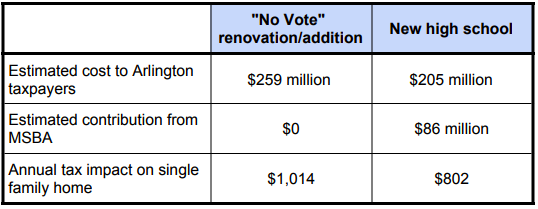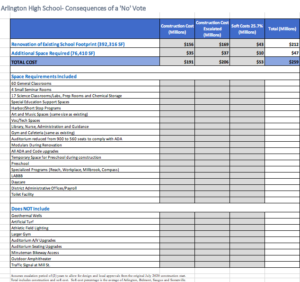At the direction of the AHS Building Committee, the Finance and Communications Subcommittees evaluated the cost of creating a working high school should Arlington vote against the debt exclusion. Because of significant enrollment growth and deteriorating facility conditions, doing nothing will not be an option; the needs are pressing and must be addressed in the next few years. This report discusses the framework, the results of the study, and assumptions. It then covers more specifics on the process that would be followed should the debt exclusion be voted down.
Framework
The conceptual framework for this evaluation was to use the Renovation-Only model created for the Preliminary Design Program as a base. The Renovation-Only model detailed an entire school built within the footprint and walls of the existing school. However, to create enough space to bring classrooms up to the correct size and number, the Renovation-Only model could not accommodate a number of essential programs. To address these programmatic elements, the group also requested our Owner’s Project Manager Skanska and Architect HMFH, to create an estimated project cost based on square footage for a new construction addition to accommodate the remaining needs. The resulting school design (designated “No Vote Reno/Addition”) was then evaluated for cost and for functionality.
Outcome and Description
The No Vote Reno/Addition school would be a school with inferior layout and facilities that would take much longer to build and cost taxpayers more than the proposed new school. To build the No Vote Reno/Addition School, Arlington taxpayers would pay at least $258.9 million, with the annual tax bill for the average single-family home increasing by $1,014 (vs $802 for the proposed new school). As a No vote would terminate our agreement with the MSBA, the scenario assumes no MSBA funding. The best-case scenario would see the building completed in 2026, taking at least 6 years after the initial decision.
The No Vote Reno/Addition school would have enough classrooms for 1,755 students, but major core spaces would be significantly undersized: cafeteria seating only 375 (vs. 585 needed), auditorium reduced for ADA compliance from 916 (existing) to 566 seats, gymnasium capable of scheduling only one class at a time. Numerous classrooms would be obstructed by columns. Almost all large educational spaces would be windowless and without natural light, including a Discourse Lab and a Performing Arts classroom created by dividing Old Hall. School layout and wayfinding would be worsened because of the need to enlarge classrooms while constrained by the building footprint; as a result, academic departments would be very spread out, impeding teacher collaboration. There would not be additional breakout spaces for student group work. Outdoor learning areas would remain inadequate. Significant improvements to the school’s environmental sustainability would be difficult. There would also be major student impacts during construction. Students would be without access to a gym or auditorium for one construction phase each (2 x 15 months). Modular classrooms would be used for the entire construction period. The accompanying spreadsheet compares the three schools (Existing, No Vote Reno/Addition, Proposed New) and gives additional details.
Download pdf of comparison chart
Assumptions
In costing out the No Vote Reno/Addition school, construction costs were escalated at 4% per year, assuming there would be at least a two-year period before construction could begin. An allowance was included to temporarily house the preschool off-site during construction. Offices for IT, Comptroller, and Facilities were assumed to be moved off-site. The following items were not included in the pricing (although included in the proposed new school): renovation of athletic fields, artificial turf and lighting, geothermal wells, bike path connection, road renovation, and a traffic signal at Mill Street. No allowances were added for costs that seem very likely to arise given the delayed timeline: additional modulars to address enrollment growth, or repairs to major mechanical systems before construction is completed.
Download pdf of the cost analysis
Process
In the event of a failed debt exclusion, the process toward renovating the existing school would be as follows: first, the decision about what to do would be made by town leadership. A plan would need to be put in place for the high school very soon because enrollment is expected to reach 1,732 by 2024, and the current building cannot hold that many students. In addition, the next New England Association of Schools and Colleges (NEASC) accreditation cycle is in 2023. In 2013, NEASC put the high school on warning because of inadequate facilities; substantive progress toward change will be required for the next evaluation.
Once a decision on action has been made, a new Owner’s Project Manager and architect/ designer would have to be hired, and funding for them would have to be obtained via a new debt exclusion vote. The design process would then take approximately two years. After the design is complete, a separate debt exclusion vote for the building would have to occur before the project could move forward. Assuming voters approved the building debt exclusion, construction could begin, with the first phase completed 15 months later (~3 years after initial decision point) and the school completed in about 4 years (~6 years after initial decision point). These schedules are aggressive, and the project would most likely take longer, and thus cost more.
MSBA funding for the No Vote Reno/Addition project would be uncertain and less likely. The town would have to reapply and be accepted back into the MSBA program. Experience from other towns suggests that being invited back into the MSBA process following a failed project can take multiple attempts, if it is approved at all. Applying for MSBA consideration would also add to the project’s timeline, potentially significantly.
Conclusion
Because of enrollment needs, deteriorating facility conditions and accreditation concerns, major work will need to be done on the high school even in the event of a failed debt exclusion. This report details the No Vote Reno/Addition school as an attempt to put numbers to this scenario. The resulting school would fall short in facilitating the educational program, have an inferior layout and facilities, while taking much longer to build and costing taxpayers significantly more than the proposed new school.



